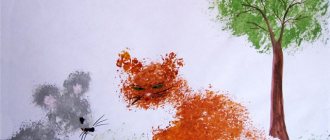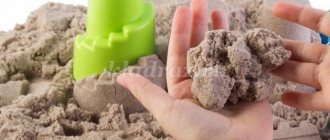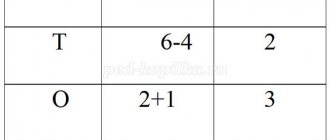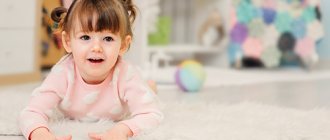Article “Features of organizing educational games with sand and water with young children”
"I bake, bake, bake"
The child “bakes” various products from sand (buns, pies, cakes). To do this, the baby can use a variety of molds, pouring sand into them, compacting them with his hand or a scoop. You can also “bake” pies with your hands, transferring wet sand from one palm to another. Then the child “treats” mom, dad, and dolls with pies.
"Fences"
The kid makes little fences in a circle with his hands. Behind such a fence you can hide a bunny from the evil gray wolf.
"Magic fingerprints in the sand"
The teacher and the child leave fingerprints on the wet sand of their hands and then complete them or add pebbles to create funny faces, fish, octopuses, birds, etc.
Games for children from 3 years old
"Warm" or "Cold"
Purpose: to consolidate the concept of “warm” or “cold”.
Content.
Two types of toys are needed, two to three of each, preferably rubber or plastic (for example: ducklings, fish, boats, dolphins and small balls - red, blue, yellow, white).
The teacher fills one container with warm water and the other with cold water. He tells the children: “Ducklings like to swim in cold water, and fish in warm water. Let's bathe them." The kid puts the ducklings in a container with cold water, and the fish in warm water. Thus, we teach the child not only the properties of objects, but also teach him to determine the difference between cold and warm.
“How does it float?”
Purpose: Introducing children to the properties of the material
Content.
To play and experiment, you need a set of objects made from different materials. A plastic boat, a rubber duck, a metal spoon, a pebble, a paper boat, a nut shell, a piece of fabric, a foam figurine, a wooden stick, etc.
The teacher invites the child to gradually lower all the objects into the water: “What a beautiful boat!” He is ready to go on a journey, to sail. Let him go into the water and let him swim. We have so many items, let’s let them go too, they want to swim.” During the game, the teacher asks the child to name the objects that are lowered into the water. Comment on the actions of objects (sinking, floating, getting wet).
"Captains"
Goal: activation of the lip muscles, development of the ability to alternate long, smooth, strong exhalations.
Content.
The teacher fills a container with water and launches a paper boat into it. The child sits on a chair nearby. An adult invites the child to take a boat ride from one shore to the other. Shows that the banks are marked with stripes of different colors. He explains that in order for the boat to move, you need to blow on it. You can simply blow by stretching your lips with a tube without puffing out your cheeks. Shows how to do it. Draws the child’s attention to the sound that is produced: “F.” The kid repeats. “But then the wind came, it was not blowing smoothly. That’s it!” - the adult blows on the boat abruptly, not evenly: “P-P-P.” Draws the baby's attention to what sound is heard now - “P.” He suggests trying to blow and drive the boat to the other shore. The game is repeated several times. The teacher makes sure that the child does not puff out his cheeks or blow too hard. During games, the teacher must praise the child for correctly completing the task, support and help, and in no case reproach the child for spilling water, scattering sand, or getting his clothes wet. Playing with sand and water should bring joy to children.
Card index of games in the center “Sand - Water” card index on the topic
CARD INDEX OF GAMES FOR EARLY CHILDREN
.
helps the teacher in solving one of the most important tasks in the development of a 2-3 year old child. We are talking about independent activity - experimenting with various suitable objects and natural materials. By organizing games with sand and water, the teacher not only introduces children to the properties of various objects and materials, but also reinforces basic ideas about the shape, size, color of objects, and develops the child’s fine motor skills. Kids love these games very much. You can pour sand from palm to palm, from a scoop into a mold, you can hide all sorts of small toys in the sand, build buildings, and then destroy them and build them again. It is noted that games with sand and water are more stable and focused than other games. Sand buildings can be considered the beginning of construction; it forces the child to concentrate. Playing with water evokes positive emotions and promotes inner relaxation. Working with children in Russia requires certain conditions; The center should be located so that it is easy to clean and that children can approach it from all sides. It is necessary to stock up on waterproof aprons, sand molds, and various washable toys.
Equipment option.
To play with sand and water, you need scoops, a variety of molds, small toys for burying (balls, cubes, rings and other geometric shapes of different colors, sizes), sticks, rakes.
For games with water - a set of rubber and plastic toys, a net, a scoop, multi-colored plastic balls, a set of toys made of various materials (floats or sinks for games). A set of pebbles, shells, etc.
Game “I bake, bake, bake”
Goal: familiarization with the properties of sand, development of coordination of movements, hand motor skills.
Contents: The child “bakes” buns, pies, and cakes from sand. To do this, the baby can use a variety of molds, pouring sand into them, compacting them with his hand or a scoop. You can also “bake” pies with your hands, transferring wet sand from one palm to another. Then the child “treats” the pies to the dolls.
Game "Warm" or "Cold"
Purpose: to consolidate the concept of “warm” or “cold”.
Contents: Two types of toys are needed, two to three of each, preferably rubber or plastic (for example: ducklings, fish, boats, dolphins and small balls - red, blue, yellow, white).
The teacher fills one container with warm water and the other with cold water. He tells the children: “Ducklings like to swim in cold water, and fish in warm water. Let's bathe them." The kid puts the ducklings in a container with cold water, and the fish in warm water. Thus, we teach the child not only the properties of objects, but also teach him to determine the difference between cold and warm.
The game “What floats?”
Purpose: To introduce children to the properties of materials.
Contents: For the game - experimentation, you need a set of objects from different materials. A plastic boat, a rubber duck, a metal spoon, a pebble, a paper boat, a nut shell, a piece of fabric, a foam figurine, a wooden stick, etc.
The teacher invites the child to gradually lower all the objects into the water: “What a beautiful boat!” He is ready to go on a journey, to sail. Let him go into the water and let him swim. We have so many items, let’s let them go too, they want to swim.” During the game, the teacher asks the child to name the objects that are lowered into the water. Comment on the actions of objects (sinking, floating, getting wet).
Game "Captains".
Goal: activation of the lip muscles, development of the ability to alternate long, smooth, strong exhalations.
Contents: The teacher fills a container with water and launches a paper boat into it. The child sits on a chair nearby. An adult invites the child to take a boat ride from one shore to the other. Shows that the banks are marked with stripes of different colors. He explains that in order for the boat to move, you need to blow on it. You can simply blow by stretching your lips with a tube without puffing out your cheeks. Shows how to do it. Draws the child’s attention to the sound that is produced: “F.” The kid repeats. “But then the wind came, it was not blowing smoothly. That’s it!” - the adult blows on the boat abruptly, not evenly: “P-P-P.” Draws the baby's attention to what sound is heard now - “P.” He suggests trying to blow and drive the boat to the other shore. The game is repeated several times. The teacher makes sure that the child does not puff out his cheeks or blow too hard. During games, the teacher must praise the child for correctly completing the task, support and help, and in no case reproach the child for spilling water, scattering sand, or getting his clothes wet. Playing with sand and water should bring joy to children.
Game "Catch a piece of ice".
Goal: development of coordination of movements, familiarization with the properties of water.
Contents: The teacher puts 5 - 10 small pieces of ice into a container of water and says to the child: “Look, look what’s happening. The ice floes were big, but they are becoming small. Let's save them!"
The child, using a net or scoop, takes out larger pieces of ice from the water and puts them in a separate bowl. After all the pieces of ice have been removed, the teacher asks: “Where did the rest of the pieces of ice go?” What happened to them? “They melted and turned into water.”
Game "Get the shell."
Goal: development of attention to coordination of movements.
Contents: An adult places several pebbles and shells at the bottom of a container with water. Then he invites the child to find the “treasure”. To do this, he chooses a very beautiful stone or shell and looks at it together with the baby. Then the pebble or shell sinks to the bottom (depth no more than 15-20 cm), the child must try to get it by finding the desired item among other stones and shells. The watery layer usually makes it difficult to get out, so an adult can help the baby a little. This activity can be recommended to parents for playing with their child on the seashore or river.
Game "Find the ball".
Goals: familiarization with the quality of objects - size, shape.
Contents: The teacher buries a small ball in the sand and asks the child to find it. First, you can bury the ball in front of the baby’s eyes, then so that he cannot see the adult’s actions. Gradually complicating the task, the teacher buries two objects, for example a ball and a cube, then asks to find one of them. You can bury objects of the same shape, but of different sizes.
Game "Bake cookies".
Goal: familiarization with the properties of sand, development of motor skills, coordination of movements.
Contents: One container contains dry sand, the other contains wet sand. The teacher shows the child beautiful molds of different styles and offers to bake cookies. The child tries to perform actions with dry sand and wet sand. Gradually, as a result of the game, the child understands that nothing can be built from dry sand, but it can be built from wet sand. If necessary, the teacher provides assistance to the child or guides his actions verbally.
Updating the developmental subject-spatial environment of the second junior group of kindergarten.
Tatyana Mukhina
Updating the developmental subject-spatial environment of the second junior group of kindergarten.
Everyone knows that, in accordance with the Federal State Educational Standard for Preschool Education, a developing subject-spatial environment is part of the educational environment , represented by specially organized space, materials, equipment and inventory for the development of preschool children in accordance with the characteristics of each age stage, protecting and strengthening them health, taking into account the characteristics and correction of deficiencies in their development . The organization of a developing subject-spatial environment is especially relevant , since it makes it possible to develop the individuality of each child, taking into account his inclinations, interests, and level of activity.
A developing subject-spatial environment must be content-rich, transformable, multifunctional, accessible, variable and safe. We all know that children’s activity centers should be created groups . Today I want to bring to your attention one of the centers -
.
Watching the activities of the children on a walk, I noticed that playing with sand was monotonous, so the idea came to update it
in
the group .
Dear teachers! I invite you to our “ Sand Courtyard ”
There is a shelf nearby, and it tells the children that everyone needs instruments to play properly.
Various toys, Sponges and shells, Pebbles, funnels, Jars and nets, Tubes and sprinklers, Everything you need to play.
You can use objects , pour, dig, pour, and, of course, be sure to follow the Rules for everyone, in our sandy , only play in pairs.







